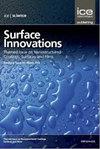Innovative isolation of colorant from Butea Monosperma for surface-modified silk dyeing
IF 3.5
4区 材料科学
Q3 CHEMISTRY, PHYSICAL
引用次数: 9
Abstract
Recently, there has been a surge of interest in adopting natural dyes to avoid the environmental difficulties connected with the synthetic coloring compounds. This research focuses on extracting natural dyes from Butea Monosperma plants and on developing sustainable dyeing methods for silk fabric. Natural colorants were extracted using an aqueous and acidic extraction procedure, and the silk fabric was dyed with the extracts using mordanting with a variety of metal and bio mordants. The treatment of fabric and extracts were carried out using microwave irradiation. It was found that after irradiation up to 3 min, the acidic extract shown maximum color strength onto fabric. It was also observed that the acacia and pine-nut hull at 80 °C and before dyeing pomegranate extract at 80 °C and after dyeing of silk fabric at 40 °C using bio-mordants were higher color strength than metallic mordant. For comparative analysis Al salt at 40 °C, Iron salt at 60 °C and tannic acid (T.A.) at 80 °C were provided acceptable results. The color fastness characteristics were also found good to excellent. The bio-mordants not only provide the higher color strength and fastness properties, it was also an environmental friendly approaches. Scanning electron microscopy (SEM) images and Fourier transform infrared spectroscopy (FT-IR) analyses revealed the difference between irradiated and un-irradiated silk fabric. Therefore, it is recommended that MW rays and bio-mordants be used in the natural dyeing of silk fabric because of their deformability and non-toxicity, as well as their high color fastness and color strength properties.创新分离布茶单精子染色用着色剂
最近,人们对采用天然染料的兴趣激增,以避免与合成着色化合物相关的环境问题。本研究的重点是从Butea单精子植物中提取天然染料,并开发丝绸织物的可持续染色方法。采用水萃取法和酸性萃取法提取天然着色剂,并用各种金属和生物媒染剂对真丝织物进行染色。采用微波辐照法对织物和提取液进行处理。结果表明,在辐照3 min后,酸性提取液在织物上的色强达到最大。同时观察到,金合欢和松子壳在80°C染色前、石榴提取物在80°C染色前、真丝织物在40°C染色后,生物媒染剂的色强均高于金属媒染剂。对比分析Al盐在40°C,铁盐在60°C和单宁酸(T.A.)在80°C提供了可接受的结果。色牢度也从良好到优异。生物媒染剂不仅具有较高的色强度和牢度,而且是一种环保的方法。扫描电子显微镜(SEM)图像和傅里叶变换红外光谱(FT-IR)分析揭示了辐照和未辐照真丝织物之间的差异。因此,建议将毫瓦射线和生物媒染剂用于真丝织物的天然染色,因为它们具有变形性和无毒性,而且色牢度和色强性能好。
本文章由计算机程序翻译,如有差异,请以英文原文为准。
求助全文
约1分钟内获得全文
求助全文
来源期刊

Surface Innovations
CHEMISTRY, PHYSICALMATERIALS SCIENCE, COAT-MATERIALS SCIENCE, COATINGS & FILMS
CiteScore
5.80
自引率
22.90%
发文量
66
期刊介绍:
The material innovations on surfaces, combined with understanding and manipulation of physics and chemistry of functional surfaces and coatings, have exploded in the past decade at an incredibly rapid pace.
Superhydrophobicity, superhydrophlicity, self-cleaning, self-healing, anti-fouling, anti-bacterial, etc., have become important fundamental topics of surface science research community driven by curiosity of physics, chemistry, and biology of interaction phenomenon at surfaces and their enormous potential in practical applications. Materials having controlled-functionality surfaces and coatings are important to the manufacturing of new products for environmental control, liquid manipulation, nanotechnological advances, biomedical engineering, pharmacy, biotechnology, and many others, and are part of the most promising technological innovations of the twenty-first century.
 求助内容:
求助内容: 应助结果提醒方式:
应助结果提醒方式:


